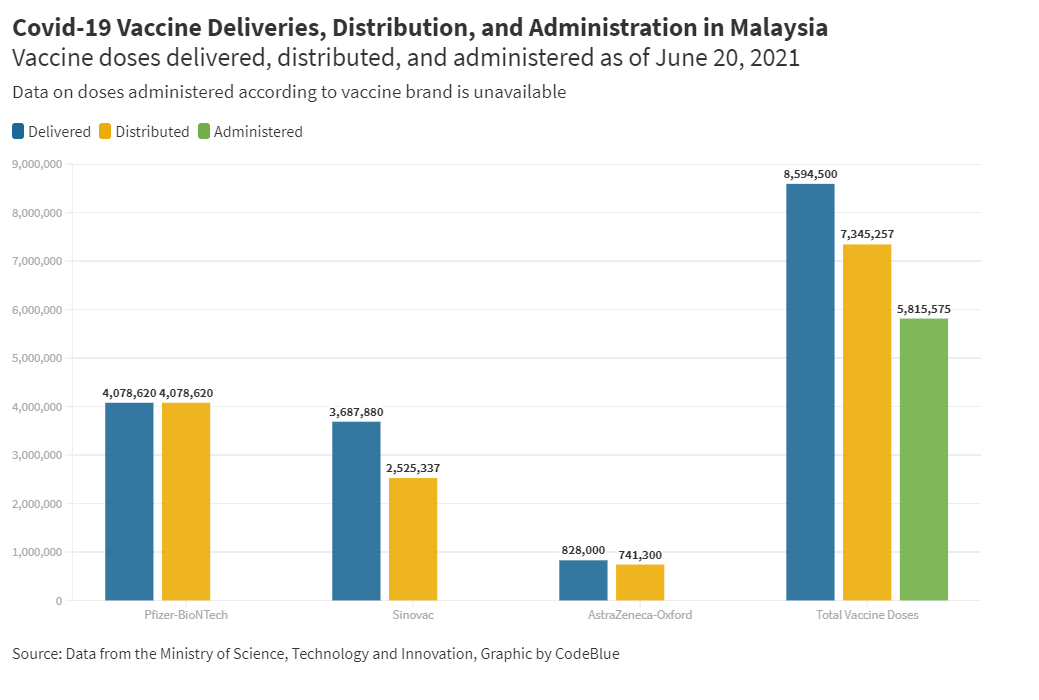KUALA LUMPUR, June 22 — The federal government has administered only about two-thirds of Covid-19 vaccine doses it received, leaving some 2.8 million doses in storage despite an increase in Malaysia’s inoculation rate.
Data provided by Vaccine Minister Khairy Jamaluddin yesterday revealed that of the 8,594,500 Covid-19 vaccine doses delivered to the federal government, 7,345,257 doses or 85.5 per cent have been distributed, while only 5,815,575 doses or 67.7 per cent of doses delivered have gone into arms nationwide as of June 20. The federal government administered 79.2 per cent of the 7,345,257 Covid-19 vaccine doses distributed across the country.
This means 2,778,925 doses have yet to be administered after delivery. As of June 20, about 4.2 million people in Malaysia have been vaccinated with at least one dose, or 12.9 per cent of the total population.
Of the 8,594,500 coronavirus vaccine doses that the country has received, 4,078,620 doses are from Pfizer-BioNTech, 3,687,880 from Sinovac, and 828,000 from AstraZeneca-Oxford.
Meanwhile, the 7,345,257 vaccine doses distributed to states comprised 4,078,620 Pfizer vaccine doses, 2,525,337 Sinovac, and 741,300 AstraZeneca.
This means that 100 per cent of the Pfizer doses in stock have been distributed, while only 68.5 per cent of the Sinovac vaccine and just under 90 per cent of the AstraZeneca vaccine have been distributed. Khairy’s office did not provide a breakdown of vaccine doses administered by brand.
The coordinating minister of the National Covid-19 Immunisation Programme (PICK) often blames delays in the national vaccine rollout to vaccine supply shortages due to late deliveries by drugmakers.
However, the amount of Covid-19 vaccines left in freezers — some one-third of doses delivered to the federal government — shows lags in the distribution and administration of shots, both of which are managed by the Ministry of Health.
Khairy said yesterday, though, that the coronavirus vaccination rate increased to 189,329 jabs daily in the past week from June 14-20, compared to 130,842 shots the previous week from June 7-13.
During yesterday’s news conference, Khairy lambasted developed countries for “hoarding” vaccine supplies, with the UK and Canada each procuring doses enough to cover more than five times their respective populations.
“It’s not that we cannot have more mega PPVs like the Bukit Jalil Stadium,” Khairy said, referring to the country’s biggest vaccination site yet, with the capacity to vaccinate up to 10,000 people per day.
“If we were to open many mega PPVs when there is not enough supply, we will end up wasting a lot of money — the people will then put the blame on the government. Once we receive our vaccine supply, we can open up more PPVs to boost our vaccination rate.
“Why don’t you compare us with our neighbours in Asia? Look at Indonesia, the Philippines, Thailand and Vietnam. We are closing in on Japan at the moment.
“You should be talking about vaccine inequity on a global scale, not just put the blame on the government. We are in the same boat as other Asian countries. We have raised this issue from the very beginning, saying that the vaccines are not distributed in a fair manner,” Khairy said.
Malaysia is expecting deliveries of an additional 444,600 doses of Pfizer’s Covid-19 vaccine this week, bringing the cumulative amount the country has received to 4,523,220 doses.
Khairy said the government is expecting 760,880 doses of the Sinovac vaccine to be distributed to facilities from yesterday. The minister is also awaiting new deliveries of the AstraZeneca vaccine in early July.
As of June 20, a total of 1,612,974 adults, or 4.9 per cent of the nation’s total 32.7 million population, have been fully vaccinated. This means about 1.6 million more people must complete two vaccine doses within the next three weeks to reach Khairy’s target of 10 per cent population coverage by mid-July.








